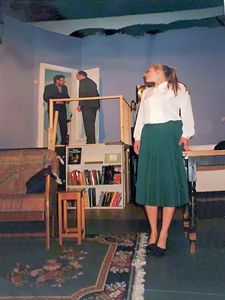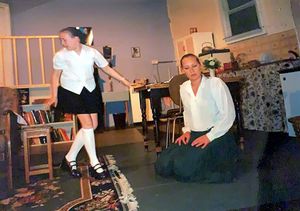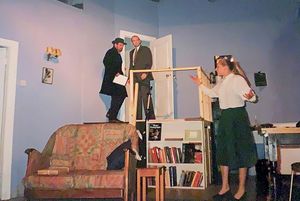Difference between revisions of "Wait Until Dark (1998)"
(→Gallery) |
|||
| (11 intermediate revisions by 5 users not shown) | |||
| Line 1: | Line 1: | ||
| − | [[Image:CHANGETHISNAME.jpg|thumb|300px|Poster by [[ | + | [[Image:CHANGETHISNAME.jpg|thumb|300px|Poster by [[Trevor Court]]]] |
by [[Frederick Knott]] | by [[Frederick Knott]] | ||
| − | Directed by [[Jack King]] | + | Directed by [[Jack King]] Produced by [[Tricia Court]] |
Performances: Tue 2nd - Sat 6th June [[1998]], [[Bell Theatre]] | Performances: Tue 2nd - Sat 6th June [[1998]], [[Bell Theatre]] | ||
| Line 10: | Line 10: | ||
== Introduction == | == Introduction == | ||
| − | ... | + | The mystery thriller's heroine is Susy Hendrix, a blind Greenwich Village housewife who becomes the target of three thugs searching for the heroin hidden in a doll her husband transported from Canada as a favour to a woman who since has been murdered. The trio tries to convince Susy her spouse has been implicated in the crime and the only way to protect him is to surrender the doll. More murder and mayhem ensue when she refuses, with the stage lights turned off for the final scene when Suzy levels the playing field by plunging her apartment into total darkness.<ref>[http://en.wikipedia.org/wiki/Wait_Until_Dark Wikipedia entry]</ref> |
| + | |||
| + | Our programme states:- The action takes place in a basement flat in an old house in Nottinghill Gate, early '60's. | ||
| + | |||
| + | Act 1: Scene 1 - Friday evening, Scene 2 - Saturday afternoon, Scene 3 - 20 minutes later. | ||
| + | |||
| + | Act 2: Scene 1 - An hour later, Scene 3 Immediately following, Scene 3 - A minute later. | ||
== Cast == | == Cast == | ||
| + | *Mike - [[Andy Smith]] | ||
| + | *Croker - [[Stephen Pitt]] | ||
*Roat - [[Ian Mill]] | *Roat - [[Ian Mill]] | ||
| − | * | + | *Susy - [[Trine Barford]] |
| + | *Sam - [[Clive Russell]] | ||
*Gloria - [[Rachel Harte]] | *Gloria - [[Rachel Harte]] | ||
| − | * | + | *1st PC - [[Jack King]] |
| + | *2nd PC - [[Steve Ellis]] | ||
== Crew == | == Crew == | ||
| − | *Stage Manager - [[ | + | *Stage Manager - [[Su Hands]] |
| − | *Lighting Design - [[ | + | *Assistant Stage Managers - [[Alice Mill]] & [[Lisa Ventham]] |
| − | * | + | *Lighting - [[Keefe Browning]] |
| + | *Sound - [[Paul O'Connor]] | ||
| + | *Set Design - [[Bernie Bullbrook]] | ||
| + | *Set Construction - [[Bernie Bullbrook]], [[Ian Mill]], [[Anton Krause]] & [[Andrew Rickinson]] | ||
| + | *Props - [[Ian Mill]], [[Trevor Court]] & [[Tricia Court]] | ||
| + | *Fight Director - [[Clive Russell]] | ||
| + | *Blindness Consultant - [[Katrina Coz]] | ||
== Reviews == | == Reviews == | ||
| − | "A thriller must keep us on the edge our seats, wanting to know more but frightened of what it may be. I was on the edge of mine for much of this production of Frederick Knott's ''Wait Until Dark'', especially when Ian Mill as Roat took the stage. With an almost monotone delivery of his lines and a menacing calm to his movement, he created an atmosphere of sinister plotting and impending disaster. Equally convincing, was the blindness of Trine Barfods character Suzy, on which we had to believe if the play was to succeed. With these essentials in place and backed up by a superbly detailed set, good lighting and scary music, Jack King directed the production towards its climax. I had not seen the play before and, all right, I admit, I guessed the heroine would win through in the end, but the suspense was maintained to the finish and my heart did beat faster at the crucial moments. In these key areas the play succeeded. | + | "A thriller must keep us on the edge of our seats, wanting to know more but frightened of what it may be. I was on the edge of mine for much of this production of Frederick Knott's ''Wait Until Dark'', especially when Ian Mill as Roat took the stage. With an almost monotone delivery of his lines and a menacing calm to his movement, he created an atmosphere of sinister plotting and impending disaster. Equally convincing, was the blindness of Trine Barfods character Suzy, on which we had to believe if the play was to succeed. With these essentials in place and backed up by a superbly detailed set, good lighting and scary music, Jack King directed the production towards its climax. I had not seen the play before and, all right, I admit, I guessed the heroine would win through in the end, but the suspense was maintained to the finish and my heart did beat faster at the crucial moments. In these key areas the play succeeded. |
However, while the suspense did build throughout the play it was not a steady process. Too often, the desire for emotional tension seemed to be expressed by turning up the volume and increasing the movement around stage ('Why are they shouting at me?' I kept thinking, and 'Less is more.') I was impressed by the unselfconscious portrayal of Gloria by Rachel Harte and the manner in which she and Trine Barfod acted together, giving us a relationship which developed in intensity and mutual understanding. Andy Smith as Mike also produced a convincing relationship with Suzy where friendship and duplicity melded realistically. At times though, actors appeared to be delivering their lines in a vacuum, seemingly unaware that their performances affected the overall shape of the play and were always in relation to other characters; a quieter approach and greater awareness of how each character relates to another, might have increased the tension still further." | However, while the suspense did build throughout the play it was not a steady process. Too often, the desire for emotional tension seemed to be expressed by turning up the volume and increasing the movement around stage ('Why are they shouting at me?' I kept thinking, and 'Less is more.') I was impressed by the unselfconscious portrayal of Gloria by Rachel Harte and the manner in which she and Trine Barfod acted together, giving us a relationship which developed in intensity and mutual understanding. Andy Smith as Mike also produced a convincing relationship with Suzy where friendship and duplicity melded realistically. At times though, actors appeared to be delivering their lines in a vacuum, seemingly unaware that their performances affected the overall shape of the play and were always in relation to other characters; a quieter approach and greater awareness of how each character relates to another, might have increased the tension still further." | ||
| Line 34: | Line 50: | ||
== Gallery == | == Gallery == | ||
| + | <gallery caption="Photos courtesy of Alice Mill" widths="300px" heights="300px" perrow="5"> | ||
| + | Image:WUDark001.jpg | ||
| + | Image:WUDark002.jpg | ||
| + | Image:WUDark003.jpg | ||
| − | + | </gallery> | |
== Reminiscences and Anecdotes == | == Reminiscences and Anecdotes == | ||
| Line 42: | Line 62: | ||
== See Also == | == See Also == | ||
| − | |||
| − | + | [[Wait Until Dark (1969)]] | |
== References == | == References == | ||
Latest revision as of 14:23, 28 August 2020

Directed by Jack King Produced by Tricia Court
Performances: Tue 2nd - Sat 6th June 1998, Bell Theatre
Contents
Introduction
The mystery thriller's heroine is Susy Hendrix, a blind Greenwich Village housewife who becomes the target of three thugs searching for the heroin hidden in a doll her husband transported from Canada as a favour to a woman who since has been murdered. The trio tries to convince Susy her spouse has been implicated in the crime and the only way to protect him is to surrender the doll. More murder and mayhem ensue when she refuses, with the stage lights turned off for the final scene when Suzy levels the playing field by plunging her apartment into total darkness.<ref>Wikipedia entry</ref>
Our programme states:- The action takes place in a basement flat in an old house in Nottinghill Gate, early '60's.
Act 1: Scene 1 - Friday evening, Scene 2 - Saturday afternoon, Scene 3 - 20 minutes later.
Act 2: Scene 1 - An hour later, Scene 3 Immediately following, Scene 3 - A minute later.
Cast
- Mike - Andy Smith
- Croker - Stephen Pitt
- Roat - Ian Mill
- Susy - Trine Barford
- Sam - Clive Russell
- Gloria - Rachel Harte
- 1st PC - Jack King
- 2nd PC - Steve Ellis
Crew
- Stage Manager - Su Hands
- Assistant Stage Managers - Alice Mill & Lisa Ventham
- Lighting - Keefe Browning
- Sound - Paul O'Connor
- Set Design - Bernie Bullbrook
- Set Construction - Bernie Bullbrook, Ian Mill, Anton Krause & Andrew Rickinson
- Props - Ian Mill, Trevor Court & Tricia Court
- Fight Director - Clive Russell
- Blindness Consultant - Katrina Coz
Reviews
"A thriller must keep us on the edge of our seats, wanting to know more but frightened of what it may be. I was on the edge of mine for much of this production of Frederick Knott's Wait Until Dark, especially when Ian Mill as Roat took the stage. With an almost monotone delivery of his lines and a menacing calm to his movement, he created an atmosphere of sinister plotting and impending disaster. Equally convincing, was the blindness of Trine Barfods character Suzy, on which we had to believe if the play was to succeed. With these essentials in place and backed up by a superbly detailed set, good lighting and scary music, Jack King directed the production towards its climax. I had not seen the play before and, all right, I admit, I guessed the heroine would win through in the end, but the suspense was maintained to the finish and my heart did beat faster at the crucial moments. In these key areas the play succeeded.
However, while the suspense did build throughout the play it was not a steady process. Too often, the desire for emotional tension seemed to be expressed by turning up the volume and increasing the movement around stage ('Why are they shouting at me?' I kept thinking, and 'Less is more.') I was impressed by the unselfconscious portrayal of Gloria by Rachel Harte and the manner in which she and Trine Barfod acted together, giving us a relationship which developed in intensity and mutual understanding. Andy Smith as Mike also produced a convincing relationship with Suzy where friendship and duplicity melded realistically. At times though, actors appeared to be delivering their lines in a vacuum, seemingly unaware that their performances affected the overall shape of the play and were always in relation to other characters; a quieter approach and greater awareness of how each character relates to another, might have increased the tension still further."
~ Audience review <ref>Scene, August 1998</ref>
Gallery
- Photos courtesy of Alice Mill
Reminiscences and Anecdotes
Members are encouraged to write about their experiences of working on or seeing this production. Please leave your name. Anonymous entries may be deleted.
See Also
References
<references/>


